by The History Chicks | May 26, 2012 | Biography Episode, Episode, Podcasts
This episode was a surprise for us. We had planned on posting a minicast about Rosa Parks to tie in with the episode on Ida B. Wells. The women’s lives had several parallels and we wanted to highlight Rosa Park’s role in the civil rights movement. But, when we sat down to talk, the talk went longer than a typical minicast. So we made it into a full length episode about the woman called, “the mother of the civil rights movement”.
Rosa Louis McCauley was born on Feburary 4, 1913 in Tuskegee, Alabama. As always, we discuss her life in detail on the podcast and merely outline it here, but her family; father James and mother Leona as well as Rosa’s younger brother, Sylvester, left Tuskegee for Pine Level, and then Montgomery, Alabama when Rosa was a child.
She was educated first in a rural school and then at Montgomery Industrial School (also called Miss White’s School), a fairly progressive school for the times run by women from the north. Many people in her early life contributed to her firm belief in equality, and taught her character traits that would serve her well. And we cover them in the podcast, stopping for a few moments extra to talk about the strength of both character and backbone, of her grandfather and her mother, as well as what life was like in the Jim Crow south.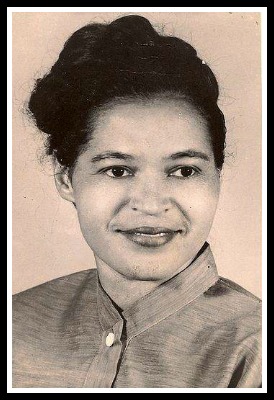
As she was entering college, Rosa had to drop out of school. Her grandmother was ill, and Rosa set off to work as a seamstress to help support her family. It is during this time that she mets a handsome, well dressed, self educated man, Raymond Parks who was a barber by trade, a civil rights activist by desire. They were wed in 1932. With his support, Rosa competed her education.
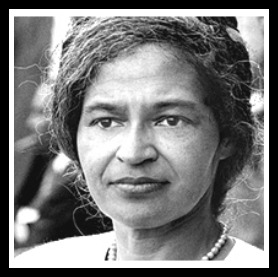
Raymond and Rosa were very active in their local NAACP chapter, working behind the scenes on cases such as that of the Scottsboro Boys, trying to make right wrongs done to blacks, trying to establish equality for all people. Rosa had served as chapter secretary, as well as working with youth programs and assisting with a very complex voter registration process.
The day that changed her life, was not Rosa’s first encounter with discrimination on a bus. She was far from the first black woman that had been arrested for not giving up her seat so that a white passenger could sit. And, in the podcast, we discuss the many people and actions that play into the success that followed when Rosa was the woman who was arrested.
JoAnn Robinson, a college professor, had gone so far as to intentionally sit in the first row of seats, seats that were always reserved for white passengers. She abandoned her protest when the bus driver kept yelling at her, but she thought that a bus boycott would make a loud impact on not only the economy of Montgomery, but also make strides in race relations.
Claudette Colvin, a teenager, had also been arrested for not giving up her seat months before Rosa.
Rosa Parks herself had also previously been asked to leave a bus for refusing to give up her seat . But on that particular December day in 1955, refuse she did again. She was tired of giving up her seat, tired of being treated in this manner. She was empowered by a series of events in her life and took a stand. By sitting.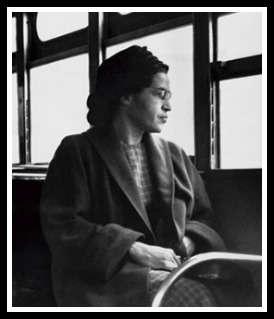
When she was arrested the black community of Montgomery got busy, fast. Jo Ann Robinson, Rev. Martin Luther King, Jr, and many community leaders did in 1955 what it takes the internet to do today: they spread the word. They formed an action plan and got the entire black population informed and organized. Within a day, what was planned as a one- day bus boycott began. It would not end until 381 days later.

Fingerprinting
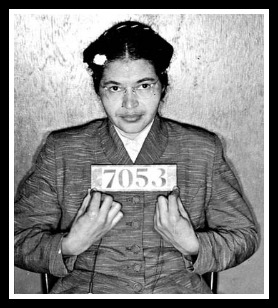
The mugshot seen around the world
By being the right woman at the right time, in the right city and with the right support, Rosa Parks, with her quiet voice and firm but proper demeanor became the mother of the civil rights movement.
Later, Rosa and Raymond moved to Detroit where she worked toward racial and gender equality as a speaker, a writer and activist.
Rosa Parks died at the age of 92, on October 24, 2005 due to complications from dementia. Even in death, she was treated as a national treasure and was allowed to lay in honor at the US Capital Rotunda and two other locations, one in Montgomery and one in Detroit.
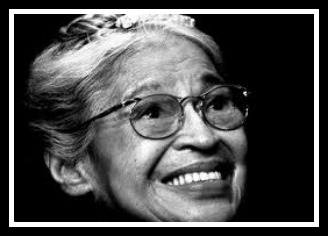
Time Travel With The History Chicks
Books! We have a few that we recommend, starting with the one written by Rosa herself, Rosa Parks: My Story.

My Story, by Rosa Parks
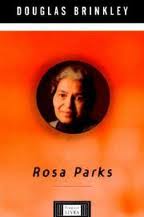
Rosa Parks, by Douglas Brinkley
The award winning children’s book that we thought was really good was,

Rosa Parks, by Nikki Giovanni, illustrated by Bryan Collier
The Rosa and Raymond Parks Institute for Self Development has a website. Lots of information as well as links to youth programs, although some of the information does seem out of date.
The free, interactive app e-book , The Road to Civil Rights, is available through this site. We didn’t read it, so if you do, send us a review! Academy of Achievement.
Movies! This is the one that we were talking about staring Angela Basset:

Rosa Parks Story
Yes, there is an American Experience for that! Eyes on the Prize.
This site has a terrific collection of photos, and videos- worth a click for those alone! Rosaparksfacts.com
There are quite a few activities on this site for kids to learn about Rosa Parks, but here is a link to an interview with her based on student’s questions.
Finally the bus! Recovered and restored with help from the Save America’s Treasures program of the National Trust for Preservation, the bus is on display at the Henry Ford Museum in Dearborn, Michigan. Even if you can’t get to Michigan, you should check out the online resources of this museum.

The restored bus
As always, music comes courtesy of Music Alley. Visit them at Music.mevio.com
by The History Chicks | May 12, 2012 | Biography Episode, Episode, Podcasts
Ida B. Wells- born a slave, educated in a post-Civil War south and left to care for her family at an early age. She grew to become a teacher, a writer, a crusader, a suffragist, a wife and mother. A woman of strength and character who dared to speak up and challenge those who desired to oppress others , even when her own safety was at risk.
How could we not talk about a woman like this?
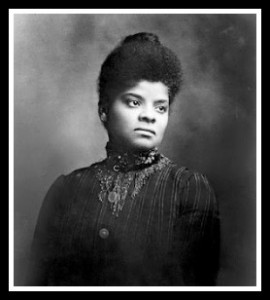
Ida was born on July 16, 1862, the first of eight children to Jim and Lizzy Wells in Holly Springs, Mississippi. Her father was the son of a plantation owner and one of his slaves; her mother a slave. As always, please know that we go into so much more detail in the podcast- the early life story of Ida’s parents is really remarkable, but what they did at the end of the Civil War is even more so.
Jim, a skilled and trained carpenter and Lizzy a highly sought after cook, put down roots and took advantage of the post war opportunities that were presented to them. Ida and her siblings were all sent to school, all raised to be hardworking, respectable and full of faith.
It was a wonderful story of pulling themselves up and being role models for their children, until a Yellow Fever epidemic hit when Ida was 16. The illness took the life of both of her parents as well as that of a young brother. She stepped up and assumed the role as head of the family. She lied about her age to get a teaching job, enlisted the help of some extended family members and did what a lot of female head of families do now: she made it work.
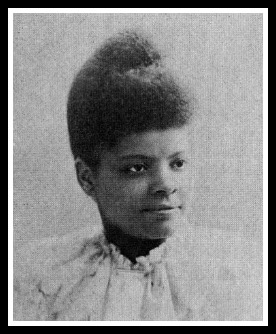
A young and determined Ida
After a few years, Ida couldn’t take the stress and pressures of the lifestyle. At this point, her siblings were getting older and some could support themselves. She had a physically handicapped sister that required live-in assistance and was sent to an aunt’s home to live. Ida took her two youngest sisters and moved to the big city of Memphis, Tennessee to live with another aunt.

Confederate money issued from Holly Springs.
With some of the responsibility off of her, Ida took another teaching job and breathed, just a little. She enjoyed all that the city had to offer and lived the life of a young woman interested in the arts, learning, and making new friends.
But it didn’t take very long for her to realize that she had more to do than attend concerts. One day,while commuting via train, she was asked to leave the Ladies’ Car for another, less comfortable one. Ida had purchased a first class ticket, as she always did, and ignored the wishes of the conductor for her to leave her first class seat- as she always did when this happened.
Only this time, the conductor didn’t ignore her and physically tried to move her. Kicking and biting and fighting back, this tiny woman stood her ground. And got kicked off the train for her efforts.
The ensuing court battle was only the beginning of the life as a political activist for Ida Wells. When she became dismayed at the inferior conditions of the school system that she worked in, she spoke up. She began writing in church newspapers about the racial disparity in the Memphis schools. And ultimately lost her job because of it. But she wasn’t done crusading for what was right.
Ida had heard about lynching, of course she had. This was the post Civil War south, but like a lot of people, she had assumed that the vigilante “justice” that was carried out was justified. Until it happened to people that she knew. Good people.
Enraged, she began to write for (and eventually ended up being a part owner of) a newspaper called The Memphis Free Speech and Headlight (later shortened to Free Speech).
This type of career- held by a woman, a black women in a racially charged South- made Ida a target. She eventually was forced to flee Memphis and landed in Chicago.
This is the part where we get to talk about her love, attorney Ferdinand Barnett who is particularly suited to sharing his life with this strong, determined, unshy woman. We talk about her life as a wife and mother, and her never ending and far reaching efforts to end lynching.
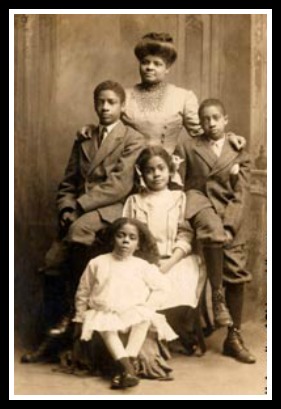
Ida with her children, courtesy of University of Chicago
Her life continued to be one of championing causes and we do cover all that in the podcast. But in addition to her anti-lynching crusade she was a suffragist, and a founder of many organizations including the NAACP. She even staged an unsuccessful run for the Illinois State Senate!
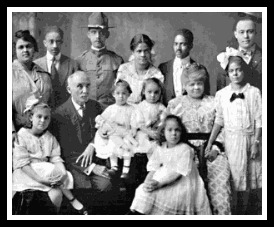
Ida and Ferdinand surrounded by kids and grandchildren
Although the organizations that she helped found began to turn their backs on her, Ida Wells-Barnett worked hard until just prior to her death at age 68 in 1931.
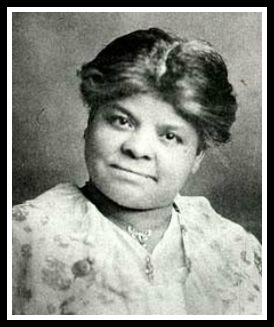 Time Travel With The History Chicks
Time Travel With The History Chicks
Ida’s family maintains a website in her honor. Find out more information about her life, get directions and information about the Ida Wells Museum in Holly Springs, click links to the Ida B.Wells Foundation and buy a t-shirt. Yes, a t-shirt. Oh, or a mug.

Ida B. Wells Museum in Holly Springs, MS
Books! Here are the ones that we recommend:

To Tell the Truth Freely, by Mia Bay

Ida Wells Memphis Diary, edited by Miriam DeCosta-Willis

They Say by, James West Davidson

Ida Wells: A sword Among Lions by, Paula J. Giddings
Here is a link to Project Guttenberg. It’s an online resource of free ebooks. This link should take you to the available Ida B.Wells publications. For *sing it* freeeeeee!
Want to peek at her Chicago house? A peek is all you can get, it’s a private residence, but that didn’t stop the National Park Service from making a page about her and the house. We love nps.gov.
You know what else we love? A good PBS American Experience and here is a very good one about the Reconstruction period.
As always, music comes courtesty of Music Alley. Visit them at music.mevio.com
























